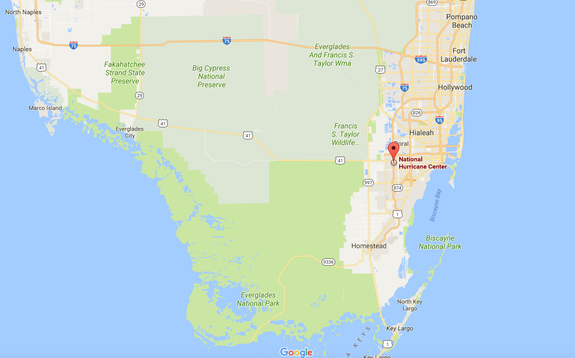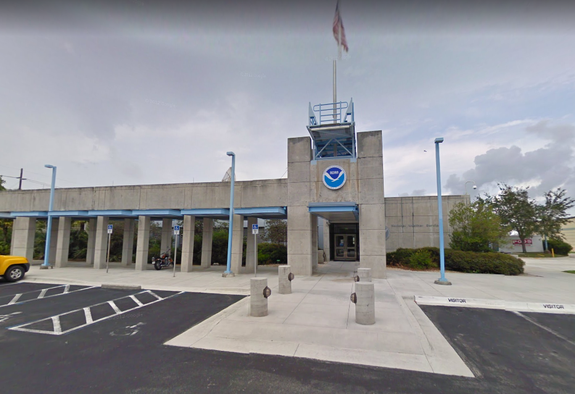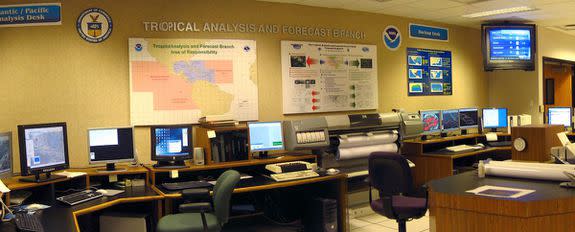National Hurricane Center's headquarters is in Irma's path—but it's built to take a hit

One of the overlooked storylines of the Hurricane Irma preparation is the very startling revelation that the National Hurricane Center (NHC), the organization that monitors hurricanes and puts out those prediction maps, is in Irma's path this weekend.
But if there's any good news to be gleaned from Irma, it's that at least the NHC has a — literally — strong foundation.
Despite its placement in the path of Irma, location is key. The NHC's headquarters are on the western side of the Florida International University (FIU) campus in Miami, a perfect spot to forecast and track the storms that roil through the Atlantic and Gulf of Mexico.

Image: Google Maps
The NHC moved to the new building in 1995, a few years after Hurricane Andrew had devastated large parts of South Florida and done some damage to the NHC's previous office.
This current HQ, though, is built to withstand some of the strongest winds possible. According to a spokesperson for NOAA, the low-slung, concrete building is capable of withstanding Category 5-level winds of up to 185 mph.

Image: Google Maps
Adding to the protection from a direct storm hit: the fortified walls are 10-inches thick and there are of course roll-down shutters to protect windows and doors, according to Kevin Hile's The Handy Weather Answer Book.
And the building's location at FIU means it's far enough from the coast — roughly 10 miles inland — that it's not affected by storm surge. It's former home, on the campus of the University of Miami, put it just two miles from the coast.
Since it opened, it's been in the path of a handful of notable storms, including an early-stage Category 1 Katrina as well as the major hurricane Wilma, both in 2005, and Hurricane Irene in 1999.

Image: Google Maps
The building also houses several other organizations, including a regional National Weather Service office, the Hurricane Liaison team, the Tropical Analysis and Forecast Branch, and the storm surge unit, making for easier communication as the storm makes landfall, something key especially in the event of a direct hit which could snarl long-distance communications.
Inside, the main hub resembles something like NASA's Mission Control with banks of computers, monitors, and other high-tech monitoring equipment arranged around a large, windowless control room, safely ensconced deep in the concrete block of the building.
Speaking of communications and hunkering down for the long-haul, the NHC building is ready for that, too.
Former NHC director Bob Sheets details how the building is fully prepared to weather the storm in his book Hurricane Watch (co-written with journalist Jack Williams).
The building, says Sheets, is equipped with backup generators and an independent water supply. There's also a pair of independent underground phone lines that are wired to different exchanges and underground fiber optic lines, as well.
And, according to Sheets, the central "safe zone" of the building "featured steel-reinforced, poured-concrete walls and an interior, steel-reinforced, poured concrete roof independent from the main building roof."
Yeah, that's pretty damn solid.

Image: NHC
And, in a worst-case scenario in which the NHC loses all power and communication, there's a back-up plan in place. According to a spokesperson for NOAA, the Weather Prediction Center in College Park, Maryland, would take over forecast duties and has already been testing its systems by issuing some of the forecast updates related to Hurricanes Katia and Jose.
In addition, hurricane specialists from both the NHC and NOAA's Pacific HQ, the Central Pacific Hurricane Center in Honolulu, Hawaii, have been sent to the WPC to aid in any forecasting duties taken on there.
For now, it seems that Irma is shifting just a bit west enough to spare Miami — and the NHC — a direct hit even as the threat of devastating high winds and heavy rains certainly remains.
But it's good to know that in a time when disaster preparation can make a drastic difference between life and death, the NHC can weather the storm.
WATCH: How to prepare for natural disasters


